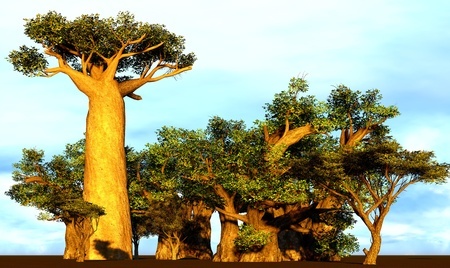Baobab - Adansonia digitata

Common Names: Baobab, monkey bread tree, dead-rat tree, upside-down tree, cream of tartar tree, Adansonia digitata, kremetart, kuka, seboi, mowana, shimuwu, muvhuya
Latin Name: Adansonia digitata (baobab, Baobabus digitata)
Origin: Africa, Asia
Short Introduction
The Baobab is most widespread across the African continent, which is also its native home. It grows in savannas where it is hot and dry, and, thanks to human cultivation, can also be found in inhabited areas. Baobab thrives in shrublands, woodlands, and grasslands. It requires full, intense sunlight to grow successfully. Baobab is extremely drought-tolerant and needs very little water during cooler periods. Despite its drought resistance, it actually benefits from rainy and humid climates and can spread rapidly under such conditions. Baobab is even capable of surviving light frost. Propagation can be done using mature seeds, which can be planted in either dry or moist soils, and it can also be grown from cuttings.
Detailed Description
Baobab is a celebrated “superfruit” boasting remarkable nutritional value.
Botanical Information
The Baobab is a large, deciduous tree with a massive, conical trunk topped with a high-set canopy from which many short, thick branches emerge. The tree can reach heights of up to 30 meters, though its average height is about 15 meters. Its trunk, often used as a water reservoir during droughts, can reach up to ten meters in diameter. The wood and bark peel off in layers, unlike traditional solid wood. As a deciduous tree, the Baobab sheds its leaves during dry parts of the year. Typically, Baobabs grow individually, standing as majestic giants in the landscape and often living for up to a thousand years. The flowers are large—up to 20 cm in diameter—white, heavy, and sweetly fragrant. While various pollinators are being studied, the consensus is that the Baobab’s pollination is most likely due to bats that feed on its nectar, as the flowers only open at night. Its fruit contains seeds encased in a dry pulp that crumbles into a powder upon falling. The scientific name “digitata” is inspired by the arrangement of leaflets—usually five per branch—giving an appearance similar to a hand.
Origin and Distribution
Baobab is native to the African flora, with a natural distribution from southern Sudan to South Africa. It is also found in Madagascar, which hosts many endemic Baobab species, though the origin of Adansonia digitata on the island is debatable. Thanks to human intervention, the Baobab has also been introduced to southern and southeast Asia, specifically through Zanzibar to India and parts of Sri Lanka. One Baobab species is indigenous to Australia.
Usage / Dosage
The Baobab plays a significant role in the cultural lives of local people—as a source of material for homes, a ceremonial gathering spot, and especially as a vital water reservoir during dry seasons. In the kitchen, the white, pulpy interior of the Baobab fruit is a fantastic source of vitamins. Baobab fruit contains an impressive amount of calcium and vitamin C, earning it the nickname “superfruit.” Its antioxidant, tonic (strengthening), and revitalizing properties are among the strongest recorded in plants, with an antioxidant activity value of 24,000 ORAC—three times higher than blueberries, and twice that of pomegranates or cranberries. Baobab pulp offers a mildly caramel, citrus-like flavor. Its compounds help harmonize the immune system and support overall vitality. High dietary fiber content—especially pectin—makes Baobab ideal for promoting healthy intestinal transit and cleansing the gut, while pectin also helps lower LDL cholesterol and benefits beneficial gut bacteria. The fruit pulp is also rich in minerals: calcium, with enough magnesium for bone, tooth, muscle, nerve, and blood-supportive synergy. The levels of fiber, calcium, and magnesium in Baobab greatly exceed those found in commonly known fruits and vegetables. In 2008, parts of Baobab gained EU approval as food ingredients (e.g., in cereals), followed by the FDA’s safety confirmation in 2009. In Africa, young Baobab leaves are eaten as a green vegetable, while the fruit pulp is used to make lemonade with a hint of citrus. Baobab bark, high in fiber, is also utilized. Baobab powder is practical in cooking and can be blended into desserts, cakes, yogurts, jams, and drinks—simply mixed with water, juice, milk, or used in baking.
Active Compounds
Baobab fruit is high in calcium, magnesium, iron, vitamin C, and pectin.
Traditional Dosage
Baobab leaves—fresh, dried, or powdered—can be consumed directly, dissolved, or steeped in milk, water, or other beverages. They are a flavor-rich ingredient suitable for sauces, soups, and sweet treats. The powder, known locally as “lalo” or “mali,” is sold widely in West Africa. Baobab seed oil is used in baking. The recommended daily intake is 5–15 grams (about 1 to 3 teaspoons), though higher amounts may be safely consumed as well.
